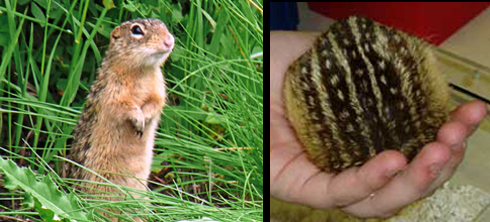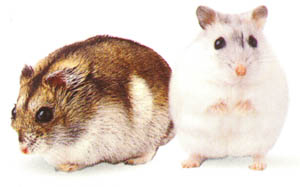

 Ground squirrels are active during the summer (left), but hibernate from autumn until spring (right; photos J. Staples)
Ground squirrels are active during the summer (left), but hibernate from autumn until spring (right; photos J. Staples)
Hibernation Metabolism: Many species of small mammals, such as this 13-lined Ground Squirrel (Ictidomys tridecemlineatus), survive winters by entering hibernation. During hibernation body temperatures may fall below freezing and metabolic rates are reduced by over 90%, conditions that would kill most mammals. My research examines the nature of this metabolic reduction at the cellular, mitochondrial and enzyme level.

In summer hamsters are active and have brown/gray fur.
As winter approaches the fur turns white and they enter daily torpor (photo by T. Bartness)
Metabolism in Daily Torpor: Other small mammals, such as this dwarf Siberian hamster (Phodopus sungorus), go through daily torpor in the winter, whereas mice enter torpor when deprived of food. Although superficially resembling hibernation, daily torpor lasts for only a few hours, and reduces body temperature and metabolic rate by relatively modest amounts. By comparing mitochondrial properties between hibernation and daily torpor we hope to better understand the mechanism of metabolic suppression.
Comparative Biochemistry of Aging: Aging and senescence are thought to be caused by the accumulation of damage by Reactive Oxygen Species (ROS, also called “free radicals”) which are produced by mitochondria. Mice, big brown bats and house sparrows have similar body masses and metabolic rates, but radically different maximum life spans - while mice live just 2-3 years, bats and sparrows can live up to 20 years. By comparing mitochondrial ROS production among these species we hope to understand what accounts for the apparent difference in rates of aging among these species.